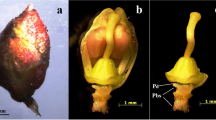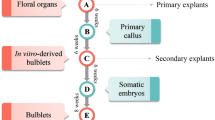Summary
This study reports the direct regeneration of flower buds from cultured sepal segments of Sinningia speciosa Hiern. Two types of floral bud regeneration were observed: regeneration of floral buds only (designed as BF) and regeneration of both floral and vegetative buds (designed as BF+V). The capacity of BF regeneration was closely related to the location of sepal segments and the concentration of exogenous gibberellin (GA3) and cytokinin in the medium. On the medium containing 1.0mgl−1 GA3, the addition of 6-benzyladenine (BA) significantly increased the frequency of total flower bud (BF+BF+V) formation, with the frequency up to 91.5% in the presence of 0.4mgl−1 BA. On the medium containing 0.1mgl−1 BA, the addition of GA3 also increased the frequency of total flower bud regeneration, with the frequency up to 74.3% in the presence of 1.0mgl−1 GA3, but no further increase in regeneration was observed when the GA3 concentration was higher than 1.0mgl−1. The capacity of BF regeneration from different locations of sepal segments was differential. The adaxial part of sepal segments gave rise to the highest frequency of 56.7 and 84.3% for BF and BF+BF+V, respectively.
Similar content being viewed by others
References
Araki, T. Transition from vegetative to reproductive phase. Curr. Opin. Plant Biol. 4:63–68; 2001.
Bernier, G. The control of floral evocation and morphogenesis. Annu. Rev. Plant Physiol. Plant Mol. Biol. 39:175–219; 1988.
Bernier, G.; Havelange, A.; Houssa, C.; Peitjean, A.; Lejeune, P. Physiological signals that induce flowering. Plant Cell 5:1147–1155; 1993.
Blázquez, M.; Green, R.; Nilsson, O.; Sussman, M.; Weigel, D. Gibberellins promote flowering of Arabidopsis by activating the LEAFY promoter. Plant Cell 10:791–800; 1998.
Bonhomme, F.; Kurz, B.; Melzer, S.; Bernier, G.; Jacqard, A. Cytokinin and gibberellin activate SaMADS A, a gene apparently involved in regulation of the floral transition in Sinapis alba. Plant J. 24:103–111; 2000.
Evans, L. T.; King, R. W.; Chu, A.; Mander, L. N.; Pharis, R. P. Gibberellin structure and florigenic activity in Lolium temulentum L., a long-day plant. Planta 182:97–106; 1990.
Gocal, G. F. W.; Poole, A. T.; Gubler, F.; Watts, R. J.; Blundell, C.; King, R. W. Long-day up-regulation of a GAMYB gene during L. temulentum inflorescence formation. Plant Physiol. 119:1271–1278; 1999.
King, R. W.; Blundell, C.; Evans, L. T. The behavior of shoot apices of Lolium temulentum L. in vitro as the basis of an assay system for florigenic extracts. Aust. J. Plant Physiol. 20:337–348; 1993.
King, R. W.; Moritz, T.; Evans, L. T.; Junttila, O.; Herlt, A. J. Long-day induction of flowering in Lolium temulentum involves sequential increases in specific gibberellins at the shoot apex. Plant Physiol. 127:624–632; 2001.
Lu, W. L. Direct regeneration of inflorescence from callus in Dracaena fragrans cy Massangeana Hort. Acta Bot. Sin. 44:113–116; 2002.
Metzger, J. D. Hormones and reproductive development. In: Davies, P. J., ed. Plant hormones: physiology, biochemistry and molecular biology. Dordrecht, The Netherlands: Kluwer Academic Publishers; 1995:617–648.
Moon, J.; Suh, S. S.; Lee, H.; Choi, K. R.; Hong, C. B.; Paek, N. C.; Kim, S. G.; Lee, I., The SOC1 MADS-box gene integrates vernalization and gibberellin signals for flowering in Arabidopsis. Plant J. 35:613–623; 2003.
Mouradov, A.; Cremer, F.; Coupland, G. Control of flowering time: interacting pathways as a basis for diversity. Plant Cell S111–S130; 2002.
Murashige, T.; Skoog, F. A revised medium for rapid growth and bioassays with tobacco tissue cultures. Physiol. Plant. 15:473–497; 1962.
Pang, J. L.; Wang, L. L.; Hu, J. Q.; Liang, H. M. Effect of gibberellin on direct regeneration of floral buds from young flower buds in Sinningia speciosa Hiern. Acta. Biol. Exp. Sin. 37:241–246; 2004.
Pharis, R. P.; Evans, L. T.; King, R. W.; Mander, L. N., Gibberellins, endogenous and applied, in relation to flower induction in the long-day plant Lolium temulentum L.. Plant Physiol. 84:1132–1138; 1987.
Tran Thanh Van, K. Direct flower neoformation from superficial tissue of small explants of Nicotiana tobacum L. Planta 115:87–92; 1973.
Wilson, R. N.; Heckman, J. W.; Somerville, C. R. Gibberellin is required for flowering in Arabidopsis thaliana under short days. Plant Physiol. 100:403–408; 1992.
Yu, H.; Ito, T.; Zhao, Y.; Peng, J.; Kumar, P.; Meyerowitz, E. M. Floral homeotic genes are targets of gibberellin signaling in flower development. Proc. Natl Acad. Sci. USA. 101:7827–7832; 2004.
Author information
Authors and Affiliations
Corresponding author
Rights and permissions
About this article
Cite this article
Pang, JL., Wang, LL., Hu, JQ. et al. Synergistic promotion of gibberellin and cytokinin on direct regeneration of floral buds from in vitro cultures of sepal segments in sinningia speciosa hiern. In Vitro Cell.Dev.Biol.-Plant 42, 450–454 (2006). https://doi.org/10.1079/IVP2006792
Received:
Accepted:
Issue Date:
DOI: https://doi.org/10.1079/IVP2006792




